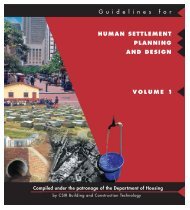METHOD A1 THE WET PREPARATION AND SIEVE ANALYSIS OF ...
METHOD A1 THE WET PREPARATION AND SIEVE ANALYSIS OF ...
METHOD A1 THE WET PREPARATION AND SIEVE ANALYSIS OF ...
Create successful ePaper yourself
Turn your PDF publications into a flip-book with our unique Google optimized e-Paper software.
2.10 A supply tank for distilled water.<br />
2.11 Paper bags, 1 kg capacity.<br />
2.12 A steel-bladed spatula, with a blade about 100 mm long<br />
3 <strong>METHOD</strong><br />
3.1 Size of test sample<br />
The size of the test sample will depend on the amount of soil fines (i.e. the portion<br />
passing the 0,425 mm sieve) present in the material. At least 300 9 of soil fines are<br />
required for the mechanical analysis and for the determination of the soil constants<br />
and the linear shrinkage. In the case of a soil which consists mostly of soil fines, a test<br />
sample of about 400 gram should prove adequate, whilst in the case of a gravel<br />
containing, for example, only 10 per cent of soil fines, the required quantity of<br />
material will be approximately 3,000 to 4,000 grams. The sample received from the<br />
field should, therefore, be quartered down by means of a riffler to the required size.<br />
3.2 Quartering<br />
3.2.1 The sample is emptied from the sample bag into one or more of the riffler pans. The<br />
material is then poured through the riffler by slowly tilting the pan so that the material<br />
flows in an even stream over the width of the pan. At the same time the pan is moved<br />
to and fro along the full length of the riffler ensuring an even flow of the material. The<br />
process is repeated with the contents of one of the pans under the riffler until a sample<br />
of the required size is obtained.<br />
3.2.2 The test sample should, of course, be representative of the field sample and it is<br />
important to ensure a free flow of the material through the openings of the riffler.<br />
Problems arise in the case of samples containing coarse aggregate, large soil clods<br />
and/or large lumps of wet clay. As these will lodge in or on the openings of the riffler,<br />
they should first be removed by sieving before the material is passed through the<br />
riffler. In such cases, the following procedure should be used:<br />
3.2.2.1 The sample is poured onto the 450mm diameter, 19,0 mm opening sieve which is<br />
placed in a 500 mm basin. Any large soil aggregations or clods retained on the sieve<br />
should be disintegrated in the mortar by applying pressure to the pestle or by tamping<br />
very lightly. The disintegrated material is added to the portion passing the sieve,<br />
which is then subdivided in the riffler as described above.<br />
The aggregate retained on the sieve is sub-divided by the method of coning and<br />
quartering. This is accomplished by forming the material into a cone which is pressed<br />
flat and by dividing into tour quadrants, rejecting the two opposite quadrants and<br />
continuing the process of coning and quartering until a portion of the required size is<br />
obtained. If the material passing the 19,0 mm sieve is divided by the riffler to obtain a<br />
portion of say a quarter of the field sample, the coarse aggregate is divided an equal<br />
number of times. That portion of the coarse aggregate is now added to the portion<br />
passing the 19,0 mm sieve and this then constitutes the test sample which is<br />
considered to be representative of the sample as received from the field (see 5.1).

















